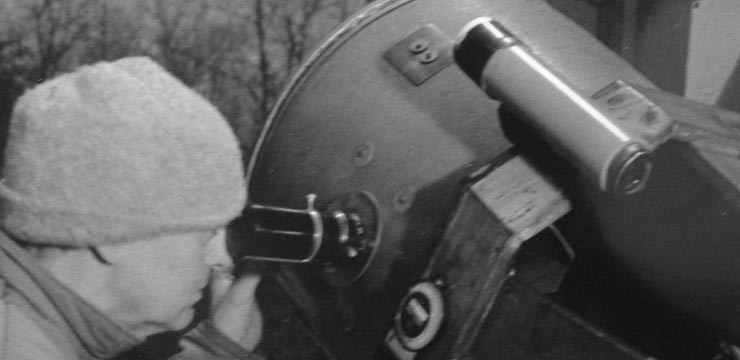
Some Memorable Nights
May 2006 :
The vast majority of my approximately 5,000 variable star observing sessions have been fairly routine affairs with no exceptional features to set them apart. This is not to say that they were boring; it only means that they do not stand out in my memory with the passing of the years. Then there are those special nights when something unusual happened, either in the sky or on the ground around me. These memorable nights stay with me to this day. I shall relate five of these to you, my fellow observers - five nights when I was rewarded by 1) good will, 2) good luck, 3) good location, 4) good connections and 5) good company.
Long-time observers will understand my greater enthusiasm for observing on moonless nights and my lesser zeal for the hunt when a bright moon is washing out all the fainter targets. Yet perhaps like me, you have been reward at least once for your determination to go out despite the diminished quality of the sky. I recall one such instance in the late 1980s. I had been observing the field of the variable star DO Draconis for about six years without ever seeing that star outburst above the limiting magnitude of my telescope. Then, unexpectedly, DO brightened to magnitude 12.4 on a night of the full moon when I had only barely motivated myself to open the observatory. The memory of that satisfaction has been sufficient to get me outside on other marginal nights when other useful observations were made.
I recall another instance when a memorable observation was made because of serendipitous conditions beyond my control, except that I was there when it happened. It was during August of 1989 when our extended family was having a weekend reunion at a camp in southern Michigan. A total lunar eclipse was to happen on Saturday night with the moon on the border between Capricornus and Aquarius. I set up our 10-inch reflector for viewing the eclipse and any occultations which might happen during the event. At the appointed time the eclipse began, culminated and ended under excellent conditions. During totality I saw that no occultations were imminent, so I began sweeping the sky near the moon and stumbled onto the field of VZ Aquarii, one of my program stars. VZ was in outburst! I am sure I would not have been able to see and report this rare event except for the coincidence of the earth’s shadow on the moon only three degrees away.
My observation of RZ Sagittae at <13.6 on the evening of August 8, 1995 was not memorable in itself. It is highlighted in my memory for two reasons: it was my 100,000th variable star observation and it was made in the shadow of the dome of the 100-inch Hale reflector at Mt. Wilson. In the summer of 1995 I was privileged to be invited by Prof. Joe Snider of Oberlin College to join the staff of CUREA, a program which allows undergraduates to do hands-on research in astronomy during a two-week stay on Mt. Wilson. My part in the program was to introduce the students to variable star observing. Unfortunately, we were on the mountain during the waxing moon and light pollution from the valley was rather bad. Nevertheless, it was a good time and I was able to continue my personal observing program using a small borrowed instrument. It was a very special place at which to reach a special milestone.
When I saw YZ Cancri rise in brightness from <14.4 to 13.8 on the might of March 4, 1987, I was sure it was the beginning of a much-anticipated outburst. I ran from the observatory to the telephone with unusual speed, for YZ was one of the targets of the International Ultra-violet Explorer (IUE) satellite team, which had just begun a one-week run in collaboration with the AAVSO. Their purpose was to study the spectra of dwarf novae during the onset of an outburst. Janet Mattei took my information on YZ and relayed it to the observing team in Madrid. They instructed the IUE telescope to target YZ Cancri and useful outburst data were gathered. It was the first time I experienced the excitement of a communication link between our backyard observatory and a team of astronomers operating a telescope in earth orbit.
One night last summer the cataclysmic variable stars FO Aquilae and AY Lyrae went into outburst at the same time. This coincidence is not extremely rare, but it sent my mind back to another time in 1985 when the same two stars were up on the same night. That night I was in the company of three dear people: my wife Helga and Clyde & Patty Tombaugh. The Tombaughs had graciously responded to our request to drop in and visit them at their home in Las Cruces a year after their visit to Seagrave. After dark I set our telescope in their backyard for a session of variable stars and other summer targets. Clyde looked through our telescope and we looked through several of his. The coincidental outbursts of FO and AY on that special night are linked in my memory to the fulfillment of a dream – for one Kansas farm boy to meet a more illustrious Kansas farm boy who had become one of his heroes.



